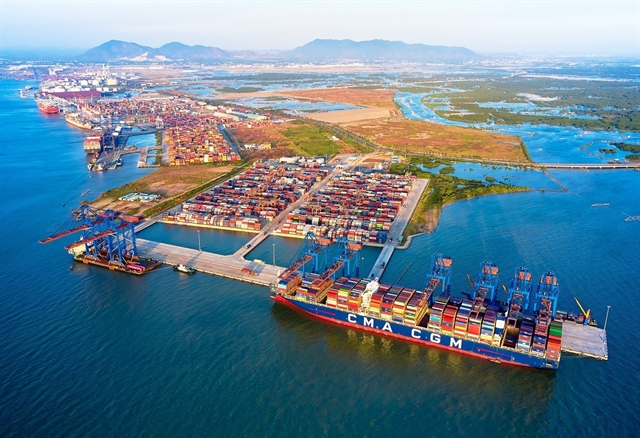There is still much to be done in order to develop Việt Nam’s logistic infrastructure and capacity despite improvement across the sector in recent years, heard participants at the Logistics Việt Nam 2023 conference held yesterday in Hà Nội.

HÀ NỘI There is still much to be done in order to develop Việt Nam’s logistic infrastructure and capacity despite improvement across the sector in recent years, heard participants at the Logistics Việt Nam 2023 conference held yesterday in Hà Nội.
Speaking at the event, deputy minister of planning and investment Trần Duy Đông said the development of the country’s logistic infrastructure has been and will continue to be among the government’s top priorities. The sector has been among some of the fastest growing in the last few decades as a result. According to the World Bank’s ranking, Việt Nam currently ranks 64th out of 160 countries in terms of logistics development and is 4th in the ASEAN region, after Singapore, Malaysia, and Thailand.
The number of logistics enterprises in the country has also been rapidly increasing. By the end of September this year, there were more than 3,000 Vietnamese domestic transport and logistics companies, along with 25 leading global freight forwarding corporations, in operation across the country, who have been providing all sorts of logistics services.
The country’s logistics sector has been among some of the fastest growing around the world. According to the Agility Emerging Markets Logistics Index, Việt Nam rose to the global Top 10 last year in a ranking of logistics indices for emerging markets, demonstrating the country’s success in developing its supply chain and readiness to adapt to the shifts by major multinational manufacturing companies worldwide.
The ranking showcased Việt Nam’s potential to attract large players in the industry, which will play an important role in the future as Southeast Asia is expected to become a large global manufacturing hub in the near future.
Industry experts and economists, however, have long voiced their concerns over limitations and shortcomings that have been hindering the development of the sector, preventing it from reaching its full potential, such as poor planning, inadequate connectivity among regions and an acute shortage of skilled labour.
In addition, Việt Nam has not been immune to geopolitical tension and inflationary pressure. As the industry starts a transformation process due to technological advancements, the rising popularity of e-commerce and green initiatives by large multinational corporations around the world addressing the above-mentioned issues has become a key objective for the sector in the years to come.
Đông said the sector’s main development targets for the future include infrastructure, technology, and human resources.
In terms of infrastructure, the deputy minister pointed out the country must quickly build strategically located warehouses that synchronize with the port system, airports, national roads, and production facilities. Meanwhile, Vietnamese logistics companies, which consist of mostly small- to -medium-sized businesses, must continue to grow in size, improve efficiency and offer additional services in order to compete with foreign businesses. Another weakness was the country’s lack of skilled labour, which must be addressed through providing extensive and formal training to workers in the sector.
“These existing limitations pose significant challenges for the future development of Việt Nam’s logistics sector. The question is how we can seize the opportunity to turn logistics into a crucial economic sector that meets domestic needs, competes internationally, and keeps up with the global development trend, focusing on green logistics and sustainable development,” Đông said.
The path ahead
Edwin Chee, CEO of SLP Vietnam, an industrial and logistics infrastructure company based in Southeast Asia, said there is a need to focus on improving the country’s existing network of road, rail, air, and sea.
In addition, he said the country must invest in building a system of smart warehouses, distribution centres and multi-functional facilities to allow more efficient cargo transportation. The application of the latest technological advances including Internet of Things (IoT), artificial intelligence (AI), data analysis, and automation can also significantly enhance the sector’s operational efficiency, inventory management, route optimisation, and customer services.
In order to realise such objectives, Việt Nam should encourage and create favorable conditions for the adoption of these technologies, through investments in modern infrastructure. He urged the government to consider giving investment incentives, tax reductions to attract more domestic and foreign businesses to enter the sector.
Elias Braham, director-general of Zim International Shipping, said Việt Nam must soon establish trading routes with additional markets including Australia, South America and Mediterranean countries, on top of traditional markets such as the US and the EU.
He said it’s time Việt Nam developed smaller ports to offer greater flexibility, reduce reliance on road networks and help bring down logistics costs for businesses. He urged local governments to work alongside logistics businesses to find solutions that help them adapt and respond quickly to developments on the international markets instead of a traditional management approach.
Meanwhile, Mai Hoàng Phương, cofounder and director-general of GHN Logistics, said businesses face difficulties staying close to urban centres as suitable locations and infrastructure have been increasingly difficult to come by.
While staying close to major cities and towns allows businesses to cut down operational costs, they must strike a balance between risk and expense. He said businesses must focus on applying the latest technologies to minimise risk and reduce shipping time, which is a vital battle to win in e-commerce.
Source: Vietnam News